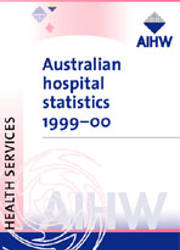Notes
Amendments and updates
Cost weight information for 1999-00 became available after the publication of Australian Hospital Statistics 1999-00. The following tables have been updated using the 1999-00 cost weights. In addition, the supplementary Internet tables S10-S17 have been updated. Morbidity data were updated for the ACT and NSW resulting in an increase in the number of separations for these jurisdictions. The updated tables also reflect this change. All tables in chapter 5 and chapter 10 have been included for completeness.
Updated Table 4.1-4.2
- Table 4.1: Summary of separation, same day separation, average cost weight, patient day and average length of stay statistics, by hospital type, Australia, 1995-96 to 1999-00
- Table 4.2: Summary of separation, same day separation, average cost weight, patient day and average length of stay statistics, by hospital type, States and Territories, 1999-00
Updated Table 5.3
- Table 5.3: Average cost weight of separations by accommodation status and hospital sector, States and Territories, 1999-00
Updated Tables 10.1, 10.2, 10.8. 10.15 and 10.16
- Table 10.1: Separation, same day separation, public patient separation, patient day, average length of stay and cost statistics by Major Diagnostic Category, public hospitals, Australia, 1999-00
- Table 10.2: Separation, same day separation, public patient separation, patient day, average length of stay and cost statistics by Major Diagnostic Category, private hospitals, Australia, 1999-00
- Table 10.7: Separation, same day separation, public patient separation, patient day, average length of stay and cost statistics for the 30 AR-DRGs version 4.1 with the highest number of separations, public hospitals, Australia, 1999-00
- Table 10.8: Separation, same day separation, public patient separation, patient day, average length of stay and cost statistics for the 30 AR-DRGs version 4.1 with the highest number of separations, private hospitals, Australia, 1999-00
- Table 10.15: Separation, public patient separation, patient day and cost statistics for the 30 AR-DRGs version 4.1 with the highest number of separations, private free-standing day hospitals, Australia, 1999-00
- Table 10.16: Separation, same day separation, public patient separation, patient day, average length of stay and cost statistics for the 30 AR-DRGs version 4.1 with the highest number of separations, public psychiatric hospitals, Australia, 1999-00
Updated Tables 2.1- 2.6, 3.1, 3.2, 3.4, 3.6, 3.7, 4.3 and A5.1
Data originally supplied by the New South Wales Health Department for some non-admitted patient occasions of service were inadvertently omitted from the publication. They are included in the updated version of
- Table 4.3: Non-admitted patient occasions of service, by type of non-admitted patient care, public acute and psychiatric hospitals, States and Territories, 1999-00
- Table 3.4: has been corrected as the version of the table published on the Internet was incorrect.
- Table 3.4: Number of hospitals and available beds per 1,000 population by metropolitan, rural and remote region, public acute and psychiatric hospitals, States and Territories, 1999--00
The release of the publication Private Hospitals Australia 1999-00 (ABS Cat no 4390.0) and the availability of other data from ABS's Private Health Establishments Collection has allowed updates to be made for the following tables:
- Table 2.6: Number of hospitals and available beds by sector and accreditation status, States and Territories, 1999-00
- Table 3.1: Summary of hospitals, Australia, 1995-96 to 1999-00
- Table 3.2: Number of hospitals and available beds by hospital sector and type, States and Territories, 1999-00
Some expenditure data that were provided late by Tasmania and New South Wales have been incorporated in the following tables. In addition, changes to Tables 2.3, 2.4 and A5.1 have been made because some newborn episodes of care with qualified days were not included in the original counts of separations (weighted or otherwise) used for hospital peer grouping. This made the average costs appear higher than the correct number. The largest effect was on the Specialist women's and children's hospitals, which have the highest proportions among the peer groups of separations being newborn episodes with qualified days. The peer grouping of five hospitals also changed with the correct counting of newborn episodes of care with qualified days. Two hospitals changed from Large metropolitan to Principal referral in New South Wales. In Queensland, one hospital changed from Medium 5,000-10,000 to Specialist women's and children's and one hospital changed from Medium 2,000-5,000 to Medium 5,000-10,000. In Victoria, one hospital changed from Small rural acute to Medium 2,000-5,000. More recently admitted patient cost proportions for some hospitals in Western Australia have been updated. A correction to assumptions about Northern Territory data was also made. It was assumed that superannuation data for the Northern Territory had been omitted but in fact it had been included in other expenditure categories. The tables updated due to these corrections were:
- Table 2.1: Cost per casemix-adjusted separation, selected public acute hospitals, States and Territories, 1999-00
- Table 2.2: Cost per acute casemix-adjusted separation (excluding psychiatric unit expenditure and activity), selected public acute hospitals, New South Wales and Victoria, 1999-00
- Table 2.3: Average costs and selected parameters by hospital peer group, Australia, 1999-00
- Table 2.4: Costs and utilisation by hospital peer group, Australia, public acute & psychiatric hospitals, 1999-00
- Table 2.5: Average salary of full time equivalent staff, public acute and psychiatric hospitals, States and Territories, 1999-00 ($)
- Table 3.6: Average full time equivalent staff, public acute and psychiatric hospitals, States and Territories, 1999-00
- Table 3.7: Recurrent expenditure ($'000), public acute and psychiatric hospitals, States and Territories, 1999-00
- Table A5.1: Public hospitals included in the National Public Hospital Establishments Database and the National Hospital Morbidity Database, 1999-00
Data tables
Supplemental versions of table 2.7 standardised to the June 2001 rather than the June 1991 population and additional information on overall utilisation in a similar format.
These supplemental tables were prepared to allow time series analysis as data in later publications is standardised to the June 2001 population. This table also contains some methodological changes and information on overall utilisation in a similar format. For details on the methodology see chapter 4 in Australian Hospital Statistics 2001-02



